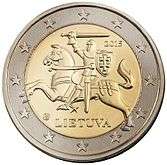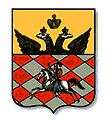Pahonia
| Pahonia | |
|---|---|
.svg.png) | |
| Versions | |
|
| |
|
| |
| Details | |
| Earlier versions |
 Grand Duchy of Lithuania |
| Use |
Belarus (1991–1995) Belarusian Democratic Republic (1918) |
The Pahonia (Belarusian: Паго́ня, transliteration: Pahonia, Belarusian pronunciation: [paˈɣonʲa]; Polish: Pogoń, Lithuanian: Vytis, literally: "Pursuer") was the coat of arms of the Grand Duchy of Lithuania, the Belarusian Democratic Republic in 1918 and of the Republic of Belarus from 1991 to 1995.
On May 14, 2007 Pahonia was declared cultural heritage of Belarus.[1]
History
Grand Duchy of Lithuania
The charging knight first emerged as a state emblem in the region in 1329 on the seal of duke Alexander Michailovich of Pskov.[2] He was deputy of Gediminas of Lithuania to Pskov which was a part of Grand Duchy of Lithuania at that time. At the same time duke Hlieb (Narimantas) of Polacak used Pahonia on his seal as well.[3] These facts illustrate that it is the most probable that Pahonia was already in use as a state symbol of Lithuania at least in 1329. However, by Gustyn Chronicle duke Vytenis of Lithuania (1293–1316) "began ruling on Lithuania and designed a coat of arms and a seal for himself and for Lithuania: armed knight riding on horse; this symbol at present time is called Pahonia" (quote by "Chronicles about Pahonia's birth").
The symbol of the charging knight on horseback passed down through the generations: from Algirdas to his son, Grand Duke Jogaila (ruled 1377 – 1392), then to Grand Duke Vytautas (ruled 1392 – 1430) and to others. By the 14th century, the charging knight on horseback with a sword had begun to feature in an heraldic shield, first in Jogaila's's seal in 1386 or 1387, and also in the seal of Vytautas in 1401. As early as the 15th century, the heraldic charging knight on horseback became the coat of arms of the Grand Duchy of Lithuania and of its central part – the Duchy of Vilnius. 16th century documents refer to it using the Polish term Pogoń. At first, the charging knight might appear riding either left or right; and sometimes he held a lance. But as of the first half of the 15th century, all depictions show him riding towards the left (as seen by the viewer), with a sword in his raised hand and a shield in the left hand.
_cut.png) Coat of arms in 1575
Coat of arms in 1575 An appearance of the coat of arms in the 16th century
An appearance of the coat of arms in the 16th century Coat of arms of the Polish-Lithuanian Commonwealth
Coat of arms of the Polish-Lithuanian Commonwealth Coat of arms of Lithuania redrawn from the 15th century Codex Bergshammar
Coat of arms of Lithuania redrawn from the 15th century Codex Bergshammar The Pahonia as depicted on the Statute of the Grand Duchy of Lithuania, 1588
The Pahonia as depicted on the Statute of the Grand Duchy of Lithuania, 1588
In the 15th century, the colors of the seal became uniform. The livery colors became fixed: a white (silver) charging knight on a red field of the heraldic shield. The charging knight at this time bore a blue shield, and set against the blue field appeared a double (gold) cross. The coat of arms featured the Grand Duke's headgear on the crest.
At first the charging knight showed the figure of the ruler of the country, but with time it came to be understood and interpreted as that of a riding knight chasing an intruder out of his native country. Such an understanding became especially popular in the 19th century and in the first half of the 20th century. The explanation has a sound historical foundation. We know that at the Battle of Grunwald (1410), where the united Polish-Lithuanian army crushed the army of the Teutonic Knights (thus putting an end to the Knights' eastward expansion) thirty Lithuanian and Ruthenian regiments out of a total of forty fought under banners flying the sign of the Pahonia.
With minor stylistic changes, the Pahonia coat of arms remained the state symbol of the Grand Duchy of Lithuania until 1795, when the Russian Empire annexed and extinguished the Polish-Lithuanian Commonwealth in the Third Partition of Poland. The Pahonia then became incorporated into the imperial state emblem. After the first partition of Poland, Catherine the Great had given the Pahonia coat of arms to several towns in the newly acquired ethnic Belarusian and Latgallian territories, including Daugavpils, Ludza, Sebezh, Polacak, Nevel, Haradok, Viciebsk, Surazh, Velizh. The motive for this was that this territory once belonged to Grand Duchy of Lithuania.

1918–1990
The Pahonia appeared on the state seal of the Belarusian Democratic Republic for a short period between 1918 and 1919. West Belarus became part of interwar Poland, and the Pahonia was used as the symbol of several provinces which had sizeable Belarusian minorities, namely the Polesie Voivodeship, the Wilno Voivodeship, and the Nowogródek Voivodeship. It was also used by West Belarusian separatist organizations. During Soviet times the emblem was forbidden and used only by Belarusian emigrant communities in the USA, Canada, and elsewhere. During the Second World War the Belarusian Central Rada, a puppet Nazi régime in Belarus, also used the Pahonia symbol.
.jpg) Passport of the Belarusian Democratic Republic, 1918-1919
Passport of the Belarusian Democratic Republic, 1918-1919 Sign of a Belarusian diplomatic mission in late 1910s - early 1920s
Sign of a Belarusian diplomatic mission in late 1910s - early 1920s.jpg) Flag of the 1st Slutsk Regiment during the Slutsk Defence Action, 1920
Flag of the 1st Slutsk Regiment during the Slutsk Defence Action, 1920
.svg.png)
1991–present
In the late 1980s, during a new wave of Belarusian national rebirth, the Belarusian Popular Front adopted the Pahonia as its emblem, despite the fact that its public display constituted a criminal offense.
In 1991, after the dissolution of the Soviet Union, the Pahonia became the coat of arms of the independent Republic of Belarus. The official design of the 1991 coat of arms of Belarus was created by a team of artists led by Jauhien Kulik and Uladzimir Krukouski basing on various Medieval designs of the Pahonia as the coat of arms of the Grand Duchy of Lithuania.[4][5]
 Payment coupon of the National Bank of Belarus, 1992, 50 kapiejkas (kopecks), reverse
Payment coupon of the National Bank of Belarus, 1992, 50 kapiejkas (kopecks), reverse.jpg) Belarusian passport, 1991-1995
Belarusian passport, 1991-1995 Constitution of Belarus, 1994
Constitution of Belarus, 1994
In 1995, following a controversial referendum, Alexander Lukashenko scrapped the Pahonia's status as the official coat of arms and replaced it with a modified Soviet emblem. Since then the Pahonia has served as one of the symbols of the anti-Lukashenko opposition in Belarus.
Lithuania joined the Eurozone by adopting the euro on 1 January 2015.[6] The designs of the Lithuanian coins share a similar national side for all denominations, featuring the Vytis symbol and the name of the country, "Lietuva". The design was announced on 11 November 2004 following a public opinion poll conducted by the Bank of Lithuania.
 Depiction of Lithuanian euro coinage, €2.00 obverse side
Depiction of Lithuanian euro coinage, €2.00 obverse side
Pahonia as a regional coats of arms
Pahonia has been the main element of emblems of all[7] Voivodeships on the lands of modern Belarus in the times of the Grand Duchy of Lithuania and the Polish-Lithuanian Commonwealth.







 Banner of the Mstsislaw Voivodeship
Banner of the Mstsislaw Voivodeship
After annexation of Belarus to the Russian Empire, the Vitebsk and Vilno governorates inherited coats of arms of their former voivodeships.
 Vilna Governorate coat of arms
Vilna Governorate coat of arms Vitebsk Governorate coat of arms
Vitebsk Governorate coat of arms
Pahonia is official emblem of the Vitsebsk voblast and part of official emblem of the Homyel voblast.
 Vitsebsk voblast coat of arms
Vitsebsk voblast coat of arms Homyel voblast coat of arms
Homyel voblast coat of arms
Appearances on urban coats of arms
While being part of the Russian Empire, some towns in Belarus, notably Vitebsk, Haradok, Polotsk and others, instituted Pahonia as part of their coats of arms. Some of them continue usage of the coats today:


 Vileyka (former coat of arms from 1845)
Vileyka (former coat of arms from 1845) Lida (former coat of arms from 1845)
Lida (former coat of arms from 1845).png) Nevel, today part of Pskov Oblast of Russia
Nevel, today part of Pskov Oblast of Russia Velizh, today part of Smolensk Oblast of Russia
Velizh, today part of Smolensk Oblast of Russia

 Siedlce, in Poland
Siedlce, in Poland Drohiczyn, in Poland
Drohiczyn, in Poland Liudvinavas, in Lithuania
Liudvinavas, in Lithuania
Rechytsa, Mahiloŭ and several other cities have historically had the Pahonia as part of their city coat of arms:


 Lipnishki
Lipnishki
Pahonia as a family coat of arms
See Pogoń Litewska
Pahonia as a political symbol
Pahonia/Pogoń has been used by several political movements on the territory of the former Grand Duchy of Lithuania and in present-day Belarus
 Emblem of the January Uprising
Emblem of the January Uprising Emblem of the Party of the Belarusian Popular Front
Emblem of the Party of the Belarusian Popular Front
Other usage
Pahonia is part of the emblems of several organizations in Belarus, including the World Association of Belarusians, the Frantsishak Skaryna Belarusian Language Society, the Union of Poles of Belarus as well as the BelaPAN news agency.[8]
Design and variations
Belarus (Pahonia)
The heraldic shield features a red field with an armored knight on a white (silver) horse holding a silver sword in his right hand above his head. A silver shield hangs on the left shoulder of the charging knight, and a golden (yellow) Patriarchal cross appears on the shield.
Ukrainian People's Republic

The rider carries a shield with the golden lion.
Lithuania (Vytis)

Main variation is a shield with the Jagiellonian dynasty coat of arms. The rider with Jagiellonian cross was popular in the Polish–Lithuanian Commonwealth and adopted for many of its voivodeships.
Gules, a knight armed cap-à-pie mounted on a horse salient argent, brandishing a sword proper and maintaining a shield azure charged with a cross of Lorraine Or.
Grand Duchy of Lithuania (Pahonya)

The rider carries a shield with the columns of Gediminas.
Ostrogski family

Sometimes the rider may carry no shield at all.
Other variations
 Minor Pogon
Minor Pogon Pogon Polska (Pogonia)
Pogon Polska (Pogonia) Pogon Tatar
Pogon Tatar
See also
- Pogoń Litewska coat of arms
- Pogoń Ruska coat of arms
- Coat of arms of the Polish–Lithuanian Commonwealth
- Coat of arms of Lithuania (Vytis)
References
- ↑ Пастанова Савета Міністраў Рэспублікі Беларусь 14 мая 2007 г. № 578 «Аб статусе гісторыка-культурных каштоўнасцей»
- ↑ About a question of aspects of foundation of Great Duchy of Lithuania (second part)
- ↑ Chronicles about Pahonia's birth
- ↑ http://www.svaboda.org/content/article/26949275.html
- ↑ http://euroradio.fm/yak-stvarali-gerb-pagonya-fota
- ↑ http://www.consilium.europa.eu/en/splash/?requested=%2fhomepage%2fhighlights%2flithuania-adopts-the-euro%2f%3flang%3den
- ↑ Emblems of historical provinces on the territory of modern Belarus
- ↑ http://belapan.com
External links
 Media related to Pahonia at Wikimedia Commons
Media related to Pahonia at Wikimedia Commons- The comparison of symbols of Lithuania and the Muscovite Ruthenia (in Russian)
- National Symbols In Belarus: The Past And Present

